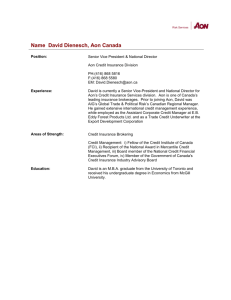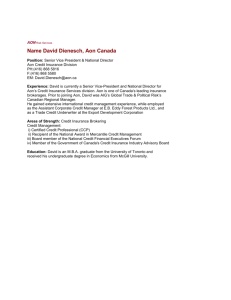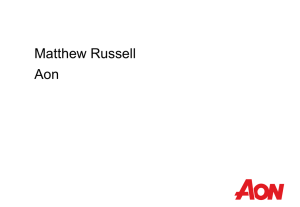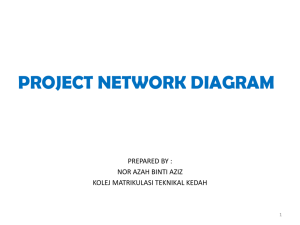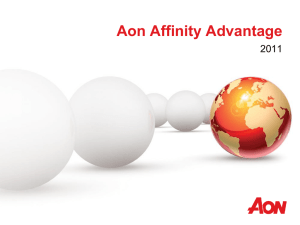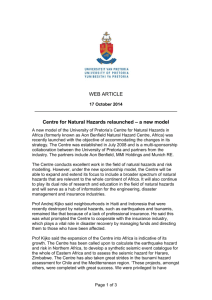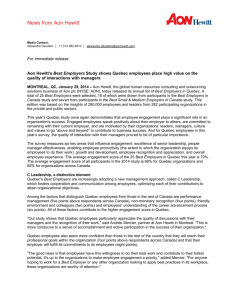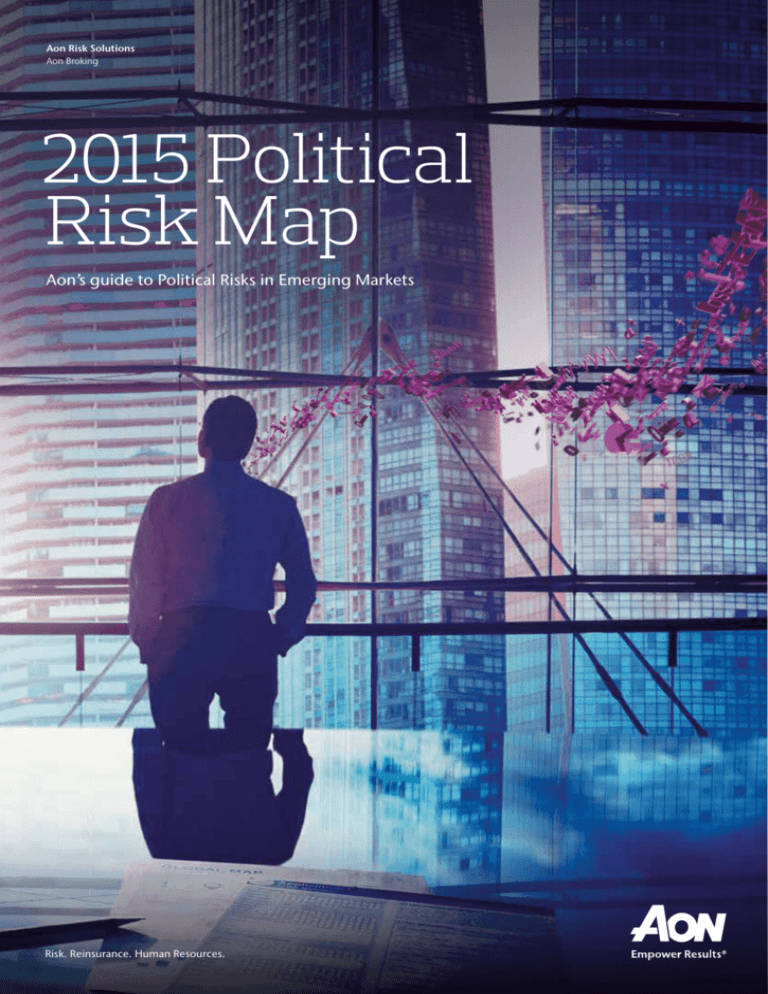
Aon Risk Solutions
Aon Broking
2015 Political
Risk Map
Aon’s guide to Political Risks in Emerging Markets
Risk. Reinsurance. Human Resources.
Table of Contents
Aon’s Political Risk Map: a guide to measure risks in emerging markets . . . . . 3
2015 Political Risk Map. . . . . . . . . . . . . . . . . . . . . . . . . . . . . . . . . . . . . . . . 4
Country Risk Rating changes in 2014:
downgrades dominate upgrades . . . . . . . . . . . . . . . . . . . . . . . . . . . . . . . 5
Country moves summarised. . . . . . . . . . . . . . . . . . . . . . . . . . . . . . . . . . . . 7
What happened in 2014:
how did we do? . . . . . . . . . . . . . . . . . . . . . . . . . . . . . . . . . . . . . . . . . . . . . 8
What to watch for in 2015 . . . . . . . . . . . . . . . . . . . . . . . . . . . . . . . . . . . . . 9
Commonwealth of Independent States/Caucasus:
the shadow of Ukraine-Russia. . . . . . . . . . . . . . . . . . . . . . . . . . . . . . . . . . 10
Middle East and North Africa: oil drag looming . . . . . . . . . . . . . . . . . . . 12
Sub-Saharan Africa: commodity and election issues. . . . . . . . . . . . . . . . 14
Asia Pacific: Resilient, but some new strains . . . . . . . . . . . . . . . . . . . . . . 16
Latin America and Caribbean: modest improvements . . . . . . . . . . . . . . 17
Brief descriptions of each risk icon. . . . . . . . . . . . . . . . . . . . . . . . . . . . . . 18
The map methodology. . . . . . . . . . . . . . . . . . . . . . . . . . . . . . . . . . . . . . . 19
Contacts . . . . . . . . . . . . . . . . . . . . . . . . . . . . . . . . . . . . . . . . . . . . . . . . . . 19
2
2015 Political Risk Map
Aon’s Political Risk Map: a guide to
measure risks in emerging markets
Emerging markets continue to be attractive for businesses seeking
alternative areas for growth. However, in less mature economies,
assets, contracts and loans can be adversely affected by government
action or inaction.
In today’s economic and geopolitical environment, it is crucial for
organisations to have a comprehensive high level overview of their
exposure to political risk on a portfolio basis.
Planning ahead and adapting risk strategies according to the level of risk
in countries of interest is of the utmost importance. Aon is well positioned
to provide a first class service in order to assist the client with this.
Unrivalled access to more than 18 years of data
Complementing the print version, the Interactive Political Risk Map
produces high level country overviews and tailored comparisons of
country ratings and changes in risk exposure over time. By accessing
Aon’s Interactive Map, organisations can track political risk exposures in
emerging market countries, both on a current and historical basis.
The data is updated quarterly and where appropriate at the time of
material political risk events. The Interactive Map and its analytical tools
allow users to plot trends, measure exposures and review the potential
risks they may face as they look to invest, grow and diversify.
An insightful guide
to assess political
risks worldwide
The map measures political
risks in 163 countries
and territories to help
organisations assess
the risk levels of:
•
•
•
•
•
•
•
•
•
Exchange transfer
Legal and regulatory risk
Political interference
Political violence
Sovereign non-payment
Supply chain disruption
The risk of doing business
Banking sector vulnerability
Risk to fiscal stimulus
At a glance, organisations can
see the political risk landscape
in their countries of interest.
Aon’s Political Risk Map is
a crucial tool for all those
with commercial interests
in emerging markets.
Aon’s Political Risk Map is produced in partnership with Roubini Global
Economics (RGE) an independent, global research firm founded in 2004
by renowned economist Nouriel Roubini.
Aon Risk Solutions
3
2015 Political Risk Map
iOS
Android
2015
Experience the Political Risk Map on your tablet or smartphone
Did you know?
Aon’s Interactive
Political Risk Map
was recognised as
the 2014 Innovation
Award Winner by
Business Insurance,
highlighting Aon’s
constant efforts to
develop innovative
client-focused
solutions
G R E E N L A N
Baffin Bay
Beaufort Sea
Davis Strait
Alaska (US)
Godthåb
Anchorage
Hudson Bay
C A N A D A
Vancouver
Québec
Montréal
Ottawa
Seattle
Toronto
Boston
Chicago
San Francisco
New York
U N I T E D S TAT E S
O F A M E R I C A
Los Angeles
Washington, D.C.
Dallas
Bermuda (UK)
Houston
New Orleans
Gulf of Mexico
MEXICO
Hawaiian
Islands (USA)
Miami
Havana
CUBA
HAITI
Cayman
Islands (UK)
Guadalajara
Kingston
Belmopan
Guatemala
GUATEMALA
DOMINICAN REP
BELIZE
Mexico City
Experience the Political
Risk Map on your tablet
or smartphone
ATLANTIC OC
BAHAMAS
JAMAICA
San José
COSTA RICA
DOMINICA
ST. LUCIA
BARBADOS
ST. VINCENT
Caracas
Panama
ANTIGUA & BARBUDA
ST. KITTS & NEVIS
Guadeloupe (Fr)
Caribbean
ANGUILLA
Netherlands
Sea Antilles (NL)
Managua
NICARAGUA
PUERTO RICO (US)
VIRGIN ISLANDS (US and UK)
Santo
Domingo
HONDURAS
Tegucigalpa
San Salvador
EL SALVADOR
Port-auPrince
VENEZUELA
GRENADA
TRINIDAD & TOBAGO
PANAMA
Georgetown
GUYANA
Paramaribo
FRENCH GUIANA (FR)
SURINAME Cayenne
Bogotá
COLOMBIA
Galapagos
Islands (Ecuador)
Quito
ECUADOR
Android
P ERU
BRAZIL
Lima
SAMOA
NIUE (NZ)
Tahiti
BOLIVIA
PACIFIC OCEAN
FRENCH
POLYNESIA
Brasilia
La Paz
TONGA
Aon Analytical Tools
Measure your exposure to political risks
Exposure Calculator
Measure your company's financial or
operational risks based on actual exposure
Rio de Janeiro
PARAGUAY
São Paulo
Asunción
Map Analysis
This tool allows you to analyse your portfolio of
countries over a period of time and across risk type(s)
URUGUAY
Santiago
Buenos Aires
CHILE
ARGENTINA
Montevideo
iOS
To access the analytical tools, please visit aon.com/2015politicalriskmap
and register or use your login details.
Falkland
Islands (UK)
Scotia Sea
Aon's political risk experts use a combination of market experience, innovative analysis tools and tailored risk transfer programmes to help you
and management programmes to respond to adverse political actions, providing balance sheet protection and business facilitation. Political a
informed decisions regarding your operations and investments.
For further information, please email prienquiries@aon.co.uk or visit www.aon.com/political-risks
© Copyright Aon Group, Inc. 2015. All rights reserved. Published by Aon Global Corporate Marketing and Communications..
4
2015 Political Risk Map
5 Political Risk Map
ARCTIC OCEAN
N D
Laptev Sea
Kara Sea
East Siberian Sea
Barents Sea
Nor wegian Sea
ICELAND
SWEDEN
Reykjavik
RUSSIA
FINLAND
NORWAY
North
Sea
Helsinki
Oslo
Stockholm
St Petersburg
Tallinn
ESTONIA
Kaliningrad
(Russia)
UNITED
KINGDOM
Dublin
London
BELGIUM
Prague
CZECH REP
FRANCE
AUSTRIA
LIECHTENSTEIN
Bern
SWITZERLAND
SLOVENIA
HUNGARY
ed
Dushanbe
TURKEY
Athens
Ashkhabad
LEBANON CYPRUS
PALESTINE
n
ISRAEL Tel Aviv
Cairo
I RA N
Baghdad
Amman
e
Gu
lf
YEMEN
f
Gul
Sana
Monrovia
TOGO
Yaoundé
COTE D'IVOIRE
SAO TOME & PRINCIPE
CENTRAL
AFRICAN REPUBLIC
SOUTH
SUDAN
HONG KONG
MACAU
Mumbai
Vientiane
Bangkok
Bay of Bengal
CAMBODIA
Phnom Penh
GUAM
LAOS
THAILAND
Ad
VIETNAM
Manila
South
China
Sea
PHILIPPINES
MICRONESIA
INDIAN OCEAN
Mogadishu
MALAYSIA
MALDIVES
NAURU
Kuala Lumpur
SOUTH SUDAN
SINGAPORE
KENYA
Nairobi
SEYCHELLES
Bujumbura
Brazzaville
KIRIBATI
PALAU
BRUNEI
DEMOCRATIC REPUBLIC
Kampala
OF CONGO
Libreville
Cabinda (Angola)
SRI LANKA
Colombo
UGANDA
GABON
CONGO
Dar-es-Salaam
TANZANIA
BURUNDI
Jakarta
SOLOMON ISLANDS
Dili
MALAWI
Port Moresby
TIMOR LESTE
COMOROS
ANGOLA
Timor
Sea
Salvador
ZAMBIA
PAPUA NEW
GUINEA
INDONESIA
RWANDA
Kinshasa
Luanda
Ascension Island (UK)
Hanoi
ETHIOPIA
Bangui
Kigali
Fortaleza
PACIFIC OCEAN
TAIWAN
BURMA (MYANMAR)
Naypyitaw
DJIBOUTI
EQ GUINEA
GHANA
Dhaka
Kolkata
Addis Ababa
CAMEROON
Lomé
Accra
Abidjan
LIBERIA
INDIA
SOMALIA
NIGERIA
Freetown
SIERRA LEONE
of
N'Djamena
BENIN
Conakry
Taipei
BANGLADESH
Karachi
Muscat
Arabian Sea
a
Bamako
Bissau
GUINEA
Abu Dhabi
UAE
Se
GAMBIA
GUINEA BISSAU
East
China
Sea
OMAN
SUDAN
Shanghai
BHUTAN
Thimphu
Khartoum
CHAD
Niamey
Katmandu
Delhi
Mecca
JAPAN
Tokyo
Osaka
NEPAL
Th
Red
ERITREA
NIGER
BURKINA
FASO
Islamabad
PAKISTAN
QATAR
SAUDI
ARABIA
Jeddah
Nouakchott
CHINA
Kabul
Wuhan
KUWAIT
BAHRAIN
MAURITANIA
CAPE VERDE
AFGHANISTAN
IRAQ
JORDAN
EGYPT
Dakar
Seoul
Tehran
Beirut
Damascus
LIBYA
MALI
Pyongyang
SOUTH KOREA
Riyadh
Banjul
NORTH KOREA
Beijing
TAJIKISTAN
SYRIA
ALGERIA
El Aaiun
Western Sahara
SENEGAL
KYRGYZSTAN
Tashkent
MALTA
Tripoli
MOROCCO
The Canaries (Sp)
TURKMENISTAN
Baku
Ankara
GREECE
ALBANIA
ite
Se rran
a
ea
TUNISIA
AZERBAIJAN
Vladivostock
Bishkek
UZBEKISTAN
Sea
Algiers
Melilla (Sp)
ian
Gibraltar (UK)
Ceuta (Sp)
Rabat
GEORGIA
ARMENIA
F.Y.R. MACEDONIA
SERBIA
M
Black
Sea
BULGARIA
MONTENEGRO
SPAIN
Ulan Bator
MONGOLIA
MOLDOVA
Bucharest
Rome
BOSNIA
Tunis
CEAN
Sarajevo
CROATIA
SAN MARINO
VATICAN
Azores (Port)
Madeira (Port)
ROMANIA
Belgrade
Madrid
Lisbon
Astana
K A Z A K H S TA N
SLOVAKIA
Casp
MONACO
ANDORRA
Minsk
BELARUS
UKRAINE Kiev
ITALY
PORTUGAL
Sea of
Okhotsk
Novosibirsk
Warsaw
GERMANY
LUXEMBOURG
Paris
Vilnius
POLAND
Berlin
NETHERLANDS
Moscow
LITHUANIA
en
IRELAND
Bering Sea
LATVIA
Riga
DENMARK Copenhagen
Lilongwe
Honiara
TUVALU
Darwin
FIJI
Lusaka
VANUATU
St. Helena (UK)
MOZAMBIQUE
Harare
ZIMBABWE
Antananarivo
MAURITIUS
MADAGASCAR
BOTSWANA
Windhoek
ATLANTIC OCEAN
NAMIBIA
Reunion Islands (Fr)
Pretoria
Maputo
Johannesburg
S O U TH
A F RI C A
New Caledonia (Fr)
KEY
Gaborone
Country risk level
AUSTRALIA
Symbols illustrating significant risks
Brisbane
SWAZILAND
Low risk
LESOTHO
Medium-low risk
Cape Town
EXCHANGE TRANSFER:
SOVEREIGN NON-PAYMENT:
Perth
Sydney
POLITICAL INTERFERENCE:
Adelaide
Medium risk
SUPPLY CHAIN DISRUPTION:
Medium-high risk
High risk
Very high risk
Non Rated
Line of Control
Canberra
Tasman
Sea
Auckland
Melbourne
NEW ZEALAND
LEGAL & REGULATORY RISK:
Wellington
POLITICAL VIOLENCE:
Christchurch
RISK OF DOING BUSINESS:
BANKING SECTOR VULNERABILITY:
INABILITY OF GOVERNMENT TO
PROVIDE STIMULUS:
SOUTHERN OCEAN
u minimise your exposure to political risks. Aon designs risk transfer
and security risk assessments are also available, allowing you to make
About Roubini Global Economics
Roubini Global Economics is a leading macroeconomic research and country risk firm best known for its accuracy in predicting
vulnerabilities and crisis. Roubini Country Risk combines expert research and risk assessment tools, enabling you to better
understand and quantitatively measure countries’ macroeconomic, political, business and social risks.
Aon Risk Solutions
5
Country risk rating changes in 2014:
downgrades dominate upgrades
There were 19 Country Risk Rating changes since the 2014 risk map was
released, compared to 15 in 2013 and 25 in 2012. As in 2013, there were
more downgrades (increases in political risk) than upgrades (reductions).
In 2014, smaller countries accounted for the majority of changes which
suggests that some of the smaller countries may now be experiencing some
of the political risks experienced in larger countries in the previous year.
One possible explanation for this trend may be the resolution of electoral
cycles in major economies in the emerging world. Another explanation is
the fact that oil producing countries experienced a generalised deterioration
in their financing outlook.
7
Upgrades
12
Downgrades
19
Country rating
changes
From the regional
perspective, Latin
America & the Caribbean,
particularly Central
America, accounted for
over half of the upgrades.
This reflected changes in
policy and benefits from
an improvement in global/
U.S. growth.
African countries
accounted for most of
the downgrades, with
fuel producers (Angola,
Ghana, Libya, Mozambique)
particularly exposed to
exchange transfer and
sovereign non-payment risk.
Seven countries were
upgraded (experiencing
a reduction in political
risk): Dominican Republic,
Ecuador, Georgia, Lao PDR,
Panama, Swaziland and
Zimbabwe
Twelve countries were
downgraded (experiencing
an increase in political risk):
Angola, Central African
Republic, Burkina Faso,
Ghana, Guinea-Conakry,
Haiti, Libya, Mozambique,
Oman, Pakistan, Sierra
Leone and Uganda
Regional trends
Upgrade
Low risk
Medium low risk
Medium risk
Medium high risk
Overall, nineteen
country rating changes
were recorded in 2014,
compared with 22 score
changes in 2013
High risk
Very high risk
Downgrade
6
2015 Political Risk Map
Country moves summarised
Date of
change
Country
2013/14
score
2014/15
score
Rating change
May 2014
CAR
H
VH
Deterioration
May 2014
Guinea
Conakry
H
VH
Deterioration
May 2014
Mozambique
M
MH
Deterioration
May 2014
Pakistan
H
VH
Deterioration
May 2014
Panama
M
ML
Improvement
Aug 2014
Ecuador
H
MH
Improvement
Aug 2014
Angola
MH
H
Deterioration
Aug 2014
Haiti
H
VH
Deterioration
Nov 2014
Georgia
MH
M
Improvement
Nov 2014
Zimbabwe
VH
H
Improvement
Nov 2014
Ghana
M
MH
Deterioration
Nov 2014
Libya
H
VH
Deterioration
Nov 2014
Burkina Faso
MH
H
Deterioration
Nov 2014
Sierra Leone
MH
H
Deterioration
Feb 2015
Dominican
Republic
MH
M
Improvement
Feb 2015
Lao PDR
H
MH
Improvement
Feb 2015
Oman
ML
M
Deterioration
Feb 2015
Swaziland
H
MH
Improvement
Feb 2015
Uganda
M
MH
Deterioration
Aon Risk Solutions
7
What happened in 2014:
how did we do?
Political risk increased significantly in 2014. This was highlighted by events in
Ukraine, Iraq, Libya, parts of Africa and Asia. Oversupply of crude oil meanwhile led
to a sharp fall in price that raised key questions about both economic and political
stability across many oil producers, adding further turbulence to the environment
for investors in emerging markets. In March and June respectively, having thrived
amid institutional weakness and power vacuums, the two threats of Ebola and ISIS
seized the global consciousness; the former after confirmation of an outbreak by
Guinea on March 22, and the latter following a lightning offensive in northern Iraq
that saw Mosul and Tikrit toppled on June 10 and 11.
We highlighted the following risks at the launch
of the 2014 Political Risk Map;
•Exchange transfer risk - economic
cycle we felt would lead to an increase
capital back from emerging and frontier
in political violence and this was
markets, which added pressure to
born out in Nigeria as well as most
countries with weak external balances.
of the BRICS. Since these elections
Most emerging markets including
have passed (aside from Nigeria)
Russia, Colombia allowed their
some political violence has subsided,
currencies to depreciate when capital
and new governments in India and
flowed out, adding to their resilience,
Indonesia have made some progress on
however some frontier markets refused
reforms, reducing some economic and
to allow this adjustment. These
political risks in 2015 and increasing
pressures resulted in soft capital controls
their resilience to future shocks
or capital restrictions being introduced
•Political interference - risks have
in Ghana, Kazakhstan and Nigeria or
remaining in place in Venezuela
•Sovereign non-payment risk - as
8
• Political violence - the heavy election
recovery in developed markets drew
risen in the face of weaker economic
growth and competition for capital.
State capitalism in all of the BRICS
fiscal balances weakened, default
created an environment more costly
risks rose in Ukraine, Russia and
for private investors, although Russia
Venezuela, as did currency pressure.
looks to be the most vulnerable;
We continue to see high willingness
anti-crisis measures reinforce the role
and ability to pay in Russia, Ukraine
of dominant state players. In Brazil
is set to negotiate restructuring of
also, political interference has led to
its debt, while in Venezuela the
underinvestment in key infrastructure,
ability to pay has weakened.
and the ongoing Petrobras corruption
Ghana, Zambia and Serbia all
scandal reflects the costs of this
signed or are in negotiations
policy, which will be negative for
with the IMF over financing
growth in 2015
2015 Political Risk Map
2014: key trends
All of these key trends
proved to be present over
the course of the year and
many will continue through
2015. Economic pressures
and financing shocks led
to a broad deterioration of
external balances and some
increase in capital restrictions
(frontier Africa and CIS),
which became even more
acute when commodity prices
came under pressure in the
second half of 2014. With
regard to Russia and Ukraine,
the online quarterly score
changes allowed the risk map
to highlight deterioration
throughout 2013 and 2014,
several quarters before the
current political crises.
On a regional basis, we
highlighted the relative
resilience of some of the richer
oil exporters in the Middle
East versus their North African
peers; a development which
has been borne out by an
intensification of the civil war
in Libya, and conflict with
ISIS in Iraq and Syria, versus
the fundamental stability in
the GCC countries, which has
been so far epitomized by a
smooth handover of power
in Saudi Arabia following
King Abdullah’s death.
What to watch for in 2015
Looking into 2015 many of the risks we highlighted in 2014 persist, while
the fall in energy prices threatens to weaken the balance sheets and test the
resilience of key producers, particularly in the Middle East and Africa. The
fight for market share in the global trade environment and sharp moves in
currency markets have put pressure on many emerging and frontier markets,
particularly with regard to exchange transfer risk, sovereign non-payment
risk and political interference.
We see the following global and regional themes as relevant
for 2015:
•Ongoing conflicts within countries
and with non-state actors create
heightened levels of political
violence and present new risks
(cyber security). Groups like
ISIS, Boko Haram and others take
advantage of porous borders and
weak institutions across parts of
the Middle East and Africa
•Deterioration in economic
risks (exchange transfer and
sovereign non-payment). Weaker
commodity prices will perpetuate
exchange transfer and sovereign
non payment risks in producing
countries. While only Venezuela
looks very vulnerable, all such
countries will face some increase
in economic risk
•Differentiation in risks among
oil exporters. Those with
more resilient institutions
and more savings will prove
better equipped, such as
GCC, Colombia, Malaysia and
Kazakhstan, versus those more
institutionally vulnerable to the
slump, namely Angola, Ghana,
Venezuela, Russia, Ecuador
•The Russia-Ukraine conflict will
weigh on the CIS region as
sanctions perpetuate high levels
of government intervention and
institutional risks
•Resilience in Latin America energy
importers and signs of reform
•While the U.S. rate hiking cycle
is likely to be modest, it implies
more competition for capital
which could increase pressure on
local exchange rates, increasing
inflationary pressures and raising
the cost of servicing external debt
Aon Risk Solutions
9
Commonwealth of Independent States/
Caucasus: the shadow of Ukraine-Russia
The escalation of the ongoing conflict in eastern Ukraine, combined with
sanctions on Russia and low oil prices, continue to cast a shadow over
the region, particularly for Russia’s larger regional trading partners such
as Belarus and Kazakhstan. Russia and Ukraine remain extremely difficult
places for businesses to operate, with severe corporate financing pressures
and government intervention in the economy having increased. In Russia’s
case the extensive role of the government in the economy and financial
sector actually reduces the chance of economic collapse or financial crisis
as government actors can work together to reduce acute risks.
Nonetheless sanctions risk remains despite recent attempts to negotiate a
ceasefire. Russia, Ukraine and the West continue to hold diverging views
of what would constitute a good outcome from the crisis, which raises
questions about the sustainability of any ceasefire. Recurrent negotiations,
a possible frozen conflict and continued sanctions will likely characterise
the situation, with resolution unlikely in 2015. Meanwhile weak growth
and recession in Russia and Ukraine will put more pressure on not only
government balances, but also on corporations and banks, increasing the
risk of corporate defaults as well as sovereign arrears.
Oil’s regional impact
The fall in oil and gas prices
reduces the financing ability
of key countries like Kazakhstan,
Uzbekistan and Turkmenistan,
where capital controls
or restrictions on foreign
exchange remain a risk. While
sovereign non-payment risk
is low, corporate defaults and
challenges in making payments
because of sanctions remain a
risk. Recession in Russia will also
weaken economic outcomes in
the region as import demand
craters and anti-immigrant
sentiment picks up, while a
decline in remittances from
Russia-domiciled expats
continues; Kyrgyzstan will be
particularly impacted by this.
Kazakhstan still looks to be the
most resilient of the central
Asian countries, with relatively
strong institutions.
Weaker rouble and import restrictions have boosted Russian inflation (percentage year-on-year)
Flood inflation
Headline inflation
25
20
15
10
5
0
Jan 12
May 12 Sep 12
Jan 13
May 13 Sep 13
Source: Haver Analytics, Roubini Global Economics
10
2015 Political Risk Map
Jan 14
May 14 Sep 14
Jan 15
May 15 Sep 15
Russia, Ukraine and the West continue to have
diverging views of what would constitute a good
outcome to the current conflict, which raises
questions about the sustainability of any ceasefire.
Aon Risk Solutions
11
Middle East and North Africa:
oil drag looming
Oil producers face a challenging year in 2015, particularly North African
exporters (Libya and Algeria), many of which already have High or Very
High country risk ratings, suggesting that they are both exposed to shocks
and lack resilience to cope with them. The oil shock will put domestic
institutions under strain and possibly weaken the security environment in
neighbouring oil importers like Egypt, Tunisia and Morocco, which would
otherwise stand to benefit from cheaper oil prices and the support to
consumption. These “Arab countries in transition” should, however, benefit
from continued support from the IMF and regional players, including
investment. We are cautiously optimistic about some of the recent
economic trends in Egypt but Political Violence risk remains high. Absent
a meaningful improvement in the security environment, Egypt’s overall
country risk rating will remain high.
In the GCC meanwhile, risks still look manageable and resilience relatively
high: Most member states have significant buffers to maintain spending,
supporting social stability. Oman, downgraded in late 2014 to Medium
High, has one of the weaker balance sheets in the GCC (sizeable fiscal
deficit and limited savings), although Political Violence risks are low.
Saudi Arabia has the financial ability to weather a low oil price, but
sustained low oil prices will force it to draw upon its fiscal resources to
maintain domestic spending (transfers to the population) and military
spending at the expense of infrastructure investment. The succession
of King Salman should continue to be relatively smooth as it was wellcoordinated and anticipated. He has already consolidated his governing
structures in a way that suggests the government is looking inward and
continuing a focus on security and stability.
UAE, Qatar and Kuwait also have sizeable stockpiles of funds and should
have space to stimulate. However the operating environment for foreign
private investors could weaken, as taxes and fees could be increased to
help fill budget gaps. Bahrain will remain reliant on Saudi Arabia’s financing.
The collapse in Yemen’s government, although consistent with its status as
a very High Risk country and effective failed state, perpetuates the risk of
proxy conflicts between Saudi Arabia and Iran and suggests it will remain a
haven for terrorist groups.
12
2015 Political Risk Map
In the Gulf
Cooperation
Council (GCC)
meanwhile,
risks still look
manageable
and resilience
relatively high.
Most member
states have
significant
buffers to
maintain
spending,
supporting
social stability
Iran’s political
risk is highly
linked to
ongoing
negotiations
over its nuclear
program
Iran and Iraq, which both have Very High risk are ill-equipped to cope
with low oil prices. Iraq in particular continues to battle ISIS in its territory,
relying on foreign military support. Although a rapprochement between the
Kurdistan regional government and the federal government has been a good
sign, political risk remains Very High and the government is inadequately
equipped to pursue needed infrastructure investment to expand oil output.
Iran’s political risk is highly linked to ongoing negotiations over its nuclear
program, with the possibility of a nuclear deal and staggered reduction
of sanctions a possible trigger for a reduction in political and economic
risk. However, Iran’s ability to benefit from a deal would be contingent
on the government’s willingness to reduce its over-involvement in the
domestic economy – Iran’s private sector has been squeezed by economic
mismanagement, sanctions and weak imports.
The financial resources of oil exporting nations vary (official reserves and sovereign assets)
Total Foreign Assets (USD Billion, right axis)
Foreign assets per capita
140
900
800
120
700
100
600
80
500
60
400
300
40
200
20
100
0
0
Venezuela Nigeria
Iraq
Kazakhstan
Iran
Libya
Algeria
Qatar
Kuwait
Russia
UAE Saudi Arabia
Source: National central banks, IMF, Roubini Global Economics
Aon Risk Solutions
13
Sub-Saharan Africa:
commodity and election issues
Sub-Saharan Africa continued to record the largest number of downgrades
in 2015, as economic and political risks increased. However, the picture is
mixed across the region with improvements in Southern African countries
offset by other weaknesses in parts of West Africa.
The Ebola outbreak exacerbated an already challenging business
environment in the most afflicted countries (Guinea, Liberia and
Sierra-Leone). Institutional quality and risk of supply chain disruption
was already high in these countries and the epidemic has exacerbated
these vulnerabilities and put extreme pressure on local health systems
and governments. Although the epidemic seems to have peaked
and been contained to these countries, the damage on institutions
will be long-lasting.
Islamic extremism, largely represented through groups such as Boko
Haram and al-Shabaab, will continue to increase political risk in Nigeria
and Somalia respectively as well as their neighbours Cameroon, Kenya
and Uganda. As a result political violence risk will remain high throughout
2015 in these countries, even if these attacks are not pervasive throughout
the whole country. Investors in key regions will need to assess their risks
directly. In Nigeria, the threat of Boko Haram has already forced the
government to invest more in military and security efforts rather than public
investment. We expect these developments will continue to weaken public
confidence in the government in Nigeria.
14
2015 Political Risk Map
In general, lower commodity
prices will see political risks remain
high and economic risks increase in
regional commodity producing nations.
In particular Angola, Cameroon, Democratic Republic
of Congo and Nigeria will have to adjust to much weaker
revenue outlooks, which imply cuts to spending, especially
public investment. Nigeria’s government will face a very difficult
fiscal position, and the new administration will have little space
to stimulate growth once elections finally take place.
Ghana’s broad-based deterioration in first economic and now
political institutions stands out, particularly its higher sovereign
non-payment risk. Ghanaian negotiations with the IMF will be
difficult, given the government’s reluctance to conduct fiscal
or structural reform and its lack of transparency on policy priorities.
The Ebola outbreak exacerbated an already challenging business
environment in the most afflicted countries (Guinea, Liberia and
Sierra-Leone). Institutional quality and risk of supply chain
disruption was already high in these countries and the epidemic
has exacerbated these vulnerabilities
Aon Risk Solutions
15
Asia Pacific:
resilient, but some new strains
Despite some improvement in Lao PDR, generally the trend has been one of
stability. Investors should watch for the ongoing reform trajectory in China.
Asia is a net beneficiary of cheaper oil, with only a few countries (Malaysia
and Vietnam) suffering from lower revenues. India and Pakistan are
particular beneficiaries, but even cheap oil will do little to improve Pakistan’s
institutional weaknesses. In general governments have taken the opportunity
to make some fiscal improvements (reduce subsidies) and increase spending
on other areas (Indonesia and India), which could help with social stability
and growth in coming years.
Political violence risks have increased slightly in Greater China, notably
Hong Kong, where protests reflected a dissatisfaction with political changes
proposed by Beijing, in the face of weaker growth. We continue to closely
watch the trajectory of economic reforms in China, which could slow growth
as they try to avoid another leveraging cycle. This transition will generate an
increase in political risk, as financial investors and property developers suffer
some losses and the government assumes some of the bad debts that have
developed during the credit binge. Extensive government intervention in
mainland China will remain a key part of the business climate, and corporate
arrears (especially within the property market) are likely to rise as credit
conditions tighten. Nonetheless the anti-corruption measures suggest the
government is using its political capital to build consensus for reforms.
16
2015 Political Risk Map
Territorial disputes
Meanwhile territorial conflicts
within Asia will remain a source
of risk. Chinese border disputes
with Japan, the Philippines,
Vietnam and others raise the
risk of arbitration and possible
skirmishes. It remains difficult
for investors to price these risks
given the range of possible
outcomes, but they remain
a key risk for supply chain
disruption across the region.
Nationalist tendencies in many
Asian countries, including
remilitarisation, will support the
defense and security sectors
but also raise the risk of policy
mistakes and may divert assets
from other areas of focus
including initiatives to support
growth in consumption.
Latin America and Caribbean:
modest improvements
Improvements throughout 2014 in business environments and a reduction
in economic risks in most of Latin America will pave the way for a stronger
2015, particularly in energy importing countries such as Jamaica, the
Dominican Republic and El Salvador.
Low oil prices will continue to hurt Venezuela, Ecuador and Brazil as well as
the stronger Colombia and Mexico (not rated). While Mexico and Colombia
are more resilient, having ample policy space, Venezuela, which already has an
elevated risk level, will struggle to cope with the shock. Ecuador and Brazil will
also experience some strains due to the problems in their policy mix.
The decline in oil revenues will increase the already high risk of sovereign
non-payment in Venezuela. The country’s capability to service its debt
is predicated on maintaining funding from China and the Middle East
and doing so comes at the cost of hoarding foreign currency, which is
leading to shortages in basic goods and hyperinflation. These adjustments
could impose strain on those of its regional neighbours such as Antigua
and Barbuda, Dominica, Grenada, Guyana and, Suriname that rely on
Venezuela for subsidised fuel.
The ongoing
corruption
scandal at
Petrobras has
contributed to
government
arrears, as has
the delay in
infrastructure
and downstream
projects
- the new
administration
has a sizeable
credibility gap to
bridge
Despite some improvements early in 2014, Ecuador’s policy trajectory is
backsliding. Ecuador responded to lower oil prices with new trade barriers
against its key trading partners Colombia and Peru. While it has little debt
to default on, and is financed by China, the business environment could
deteriorate as political interference increases.
Lower oil prices will hurt Brazil’s investment outlook despite its status as
a net energy importer. The election failed to reduce political risk in Brazil,
which has been elevated by the weak growth outlook and uncertainty
about the planned implementation of fiscal reforms. This fiscal adjustment
will be damaging in the short-term to growth and social stability.
Concern over the ongoing corruption scandal at Petrobras has grown and
contributed to government arrears, as have the delays in existing and new
infrastructure and downstream projects. Non-payment risks (temporary
arrears) associated with some state-owned enterprises are rising, even if
the Brazilian sovereign has a high ability and willingness to meet its debt
service requirements. The new administration has a sizeable credibility gap
to bridge but we do expect marginal improvements and some reduction of
government involvement in the business sector.
Aon Risk Solutions
17
Brief descriptions of each risk icon
Exchange Transfer: The risk of being
unable to make hard currency payments
as a result of the imposition of local
currency controls. This risk looks at various
economic factors, including measures of
capital account restrictions, the country’s
de-facto exchange rate regime and foreign
exchange reserves
Sovereign Non-Payment: The risk of
failure of a foreign government or
government entity to honour its
obligations in connection with loans or
other financial commitments. This risk
looks at measures of both ability and
willingness to pay, including fiscal policy,
political risk and rule of law
Legal and Regulatory: The risk of financial
or reputational loss as a result of difficulties
in complying with a host country’s laws,
regulations or codes. This risk comprises
measures of government effectiveness,
rule of law, wider property rights and
regulatory quality
Supply Chain Disruption: The risk of
disruption to the flow of goods and/
or services into or out of a country as a
result of political, social, economic or
environmental instability
Political Interference: The risk of host
government intervention in the economy
or other policy areas that adversely
affect overseas business interests; e.g.
nationalisation and expropriation. This risk
is composed of various measures of social,
institutional and regulatory risks
Political Violence: The risk of strikes, riots,
civil commotions, sabotage, terrorism,
malicious damage, war, civil war, rebellion,
revolution, insurrection, a hostile act by
a belligerent power, mutiny or a coup
d’etat. Political violence is quantified using
measures of political stability, peacefulness
and specific acts of violence
Risks of Doing Business: The regulatory
obstacles to setting up and operating
business in the country, such as excessive
procedures, the time and cost of
registering a new business, dealing with
building permits, trading across borders
and getting bank credit with sound
business plans
Banking Sector Vulnerability: The risk
of a country’s domestic banking sector
going into crisis or not being able to
support economic growth with adequate
credit. This risk comprises measures of the
capitalisation and strength of the banking
sector, and macro-financial linkages such
as total indebtedness, trade performance
and labour market rigidity
Risks to Fiscal Stimulus: The risk of the
government not being able to stimulate
the economy due to lack of fiscal
credibility, declining reserves, high debt
burden or government inefficiency
18
2015 Political Risk Map
The map methodology
Analysis and findings
Contacts
Aon partnered with Roubini Global Economics (RGE), an independent,
global research firm founded in 2004 by renowned economist Nouriel
Roubini, to produce the Political Risk Map in order to take advantage of
RGE’s unique methodology, Country Insights, for systematically analysing
political risk around the world.
Matthew Shires
Head of Political Risk
matthew.shires@aon.co.uk
+44 (0)20 7086 4373
The Aon Political Risk Map is unique as it follows a 3-layered approach in analysing
political risk in emerging market countries (excluding EU and OECD countries).
Charles Keville
Technical Director, Political Risk
charles.r.keville@aon.co.uk
+44 (0)20 7086 3098
Country ratings reflect a combination of:
• Analysis by Aon Risk Solutions
• Analysis by Roubini Global Economics
• The opinions of 20+ Lloyd’s syndicates and corporate insurers actively
writing political risk insurance
Country insights as applied to the map allows clients:
• To track changes in countries systematically
• To obtain more meaningful country comparisons
• To break down each risk to show the various elements that drive that risk
For further information, please visit Roubini’s website: www.roubini.com
Perils analysed
Each country is assigned a rating starting at Low, Medium Low, Medium,
Medium High, High, Very High. The scores reflect the severity of risk in
each state against nine core risk perils.
The map depicts 9 individual Risk Icons. Country Rating for the map includes
input from the six primary risk icons (Exchange Transfer, Legal and Regulatory,
Political Interference, Political Violence, Sovereign Non-payment and Supply
Chain Disruption) but three separate icons are also provided (Risks to Doing
Business, Banking Sector Vulnerability and Risks to Fiscal Stimulus).
They are not intended to predict global events or future threats. The scores
are weighted to accommodate a wide range of political risk variables.
Aon Risk Solutions
19
About Aon
Aon plc (NYSE:AON) is a leading global provider
of risk management, insurance and reinsurance
brokerage, and human resources solutions and
outsourcing services. Through its more than
66,000 colleagues worldwide, Aon unites to
empower results for clients in over 120 countries
via innovative and effective risk and people
solutions and through industry-leading global
resources and technical expertise. Aon has been
named repeatedly as the world’s best broker, best
insurance intermediary, reinsurance intermediary,
captives manager and best employee benefits
consulting firm by multiple industry sources. Visit
www.aon.com for more information on Aon and
www.aon.com/manchesterunited to learn about
Aon’s global partnership with Manchester United.
© Aon plc 2015. All rights reserved.
The information contained herein and the statements expressed
are of a general nature and are not intended to address the
circumstances of any particular individual or entity. Although
we endeavor to provide accurate and timely information and
use sources we consider reliable, there can be no guarantee that
such information is accurate as of the date it is received or that it
will continue to be accurate in the future.
No one should act on such information without appropriate
professional advice after a thorough examination of the
particular situation.
Aon UK Limited is authorised and regulated by the Financial
Conduct Authority.
FP 8830
www.aon.com
Risk. Reinsurance. Human Resources.

